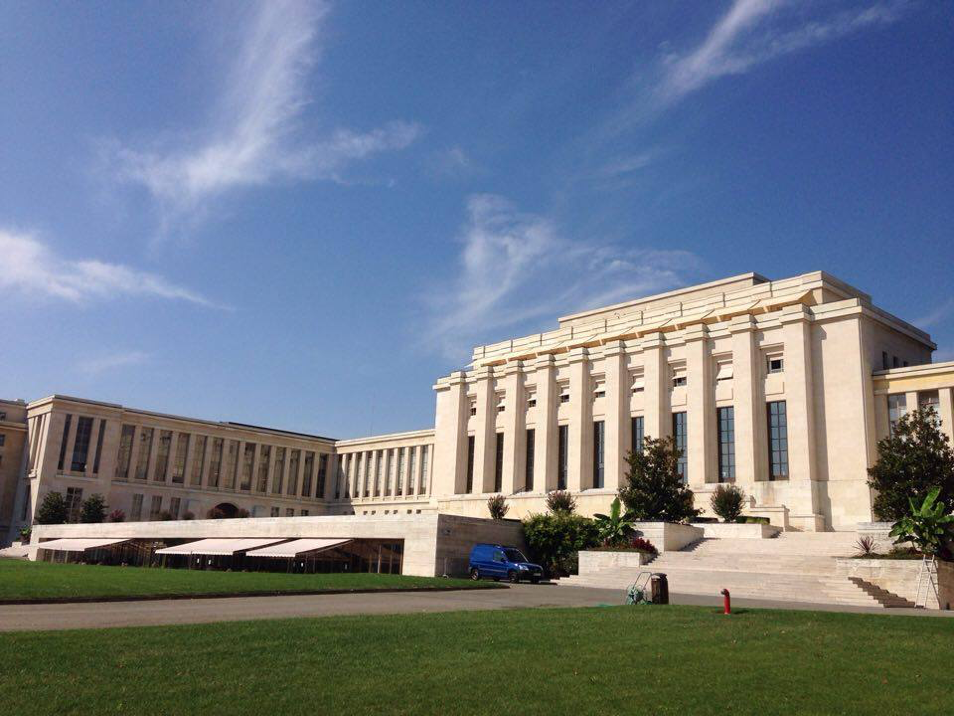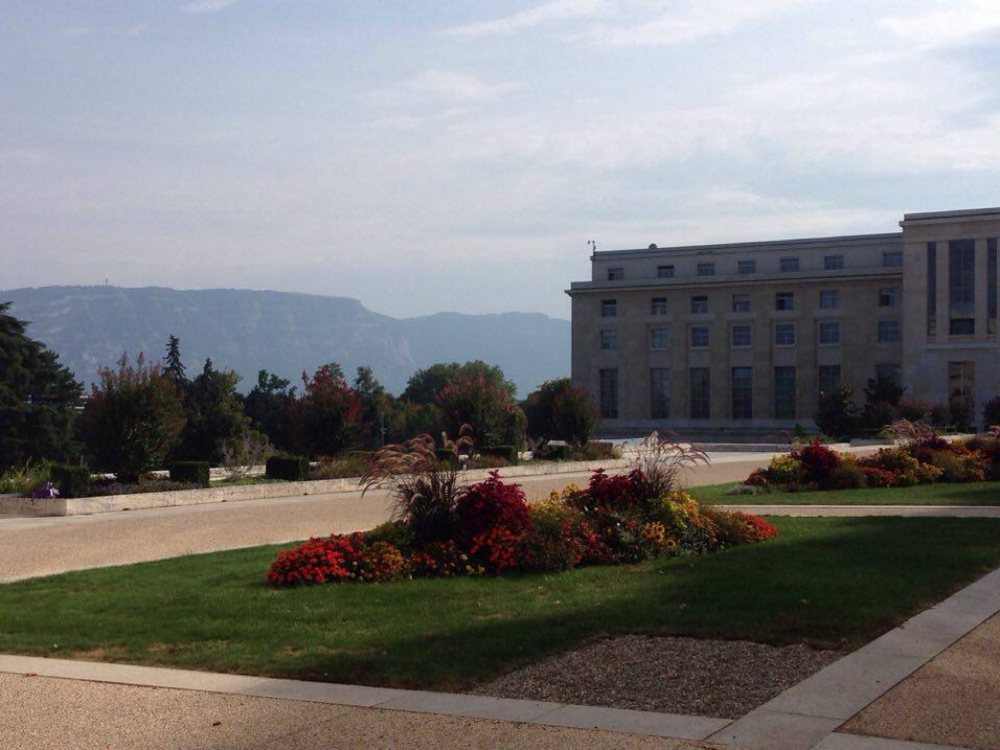L’esprit de Genève 2016 – Or: My First Meeting with the Archives of the United Nations Office of Geneva
Blog entry by Emil Eiby Seidenfaden (PhD Student - Aarhus University)
“If I were you” wrote the American journalist Walter Lippmann to first under-secretary of the League of Nations Raymond Fosdick in 1919, “I would make it all about publicity.”
Lippmann was a fierce critic of the Treaty of Versailles, and the offspring of the Paris Peace Conference – the League of Nations. His words fell in response to Fosdick who had asked him, in an earlier letter, for some constructive advice instead of the easy criticism. The League was coming into being after all, so even if it was a dysfunctional thing, something useful would have to be made of it.
With his phrasing: “make it all about publicity,” Lippmann managed to, on the one hand, communicate his deep skepticism towards any actual political muscle or impact of the League of Nations, but it seems as if, on the other hand, he also bought into a widely held belief that publicity-borne internationalism was to be the key to peacekeeping. It had indeed been written into the idea of the League by the American President Woodrow Wilson and many of his contemporaries that the opening of diplomacy was the best way to prevent something like the disaster of the First World War from ever happening again. The gates to the marble halls of the Palais des Nations would be opened and visitors in the thousands could themselves behold the new international machinery that would work day and night to keep the peace.
On a hot September day almost a hundred years later, as I was waiting in line for the security check into the U.N compound in Geneva on my first archival mission in connection to my Ph.d-thesis, it struck me that even today publicity is front and center in the U.N. This could be observed even before having passed the security-checkpoint into the compound.
There were three lines to the security check: One for tourists and their guided tours. One for U.N employees and national delegates, and one for people like me, who needed a temporary badge to do some kind of work inside the compound for a limited time period.
The U.N employee line was the most efficient – that was fair enough – but it was also by far the shortest one. This was probably because U.N staff, with their multitude of languages, clothes, shapes, sizes and skin-colors, have many alternative ways into the compound.
Then there were the tourists. There were hundreds, thousands it sometimes seemed. And the guards were uncompromising in giving them priority over us – the “nobodies” who actually had something to do in there. Most people in my line were in some kind of a hurry – NGO-workers and the like who needed temporary badges for a big Human Rights Conference that was starting that Tuesday. And while I do realize that a Ph.d-student in need of a library pass is not very important at all, those other people in my line (I talked to a Nigerian and an American from the Red Cross as well as a British journalist) didn’t quite deserve to wait two hours and fifty minutes in line. Two hours and fifty minutes all in the name of publicity – the tourist were clearly the real testifiers to the wonder of international organization.
The Palais des Nations had better not disappoint I thought, as I was finally let though by the benevolently smiling mountain of a security guard.
And it didn’t.

The Palais des Nations
The Palais des Nations brings to mind the consulates (former embassies) of foreign countries in cities that used to be capitals but are not anymore: The Palais is vastly over-impressive for its current purpose. Perhaps this is not simply because its purpose used to be a greater one than it is today, but also because its physical impression is hoped to provide institutional ethos in itself – a power center of publicity.
The constant urge to squeeze publicity out of everything is very clear in matters concerning the buildings. I encountered a draft of a League Information Pamphlet about the Palais when it finally stood finished in 1937. With the benefit of hindsight, one is struck by a feeling of tragedy reading page after page of excited text about the long-awaited buildings no-doubt the result of a long, hair-splitting, internal correspondence in the meticulous Information Section of the League.
Having only seen the U.N headquarters in New York from the outside, I still hold that the UNOG (United Nations Office of Geneva), whose main building is the Palais, is much, much more beautiful and at least equally awe-inspiring in its style.
It is set on the seaside of the grand Lake Geneva, a massive park with sculptures and monuments surrounding it. The architecture is both interwar modernist and neoclassicist and was the result of a long process of political compromises between the financing partners of the League. The gardens are wonderfully peaceful and pretty in good weather. Large peacocks (the actual birds!) wander about in them. I met three on the first day. And the archives …
The archives of the UNOG is not hidden away in the basement of some sad outlying part of the compound. It is located on the third floor of what must be the north-east wing of the Palais itself. The walls of the reading room are decorated with paintings of the American President Woodrow Wilson, the first Secretary-General of the League of Nations Eric Drummond, and other protagonists of the League’s tragically short existence in this beautiful setting.
Polite and soft-spoken archivists stand ready to bring out boxes upon boxes of League artifacts and documents on request. It is, in short, a pleasure to be there and most of the time it manages to compensate just fine for the loneliness of a two-weeks archive trip to a new city.
The research
And what is my project?
At the moment of writing this I have been researching for a week in the archive and have one week left. My Ph.d-project is part of the overall research project Inventing International Bureaucracy (…). Under the umbrella of this large project I have chosen to focus my attention on the publicity and propaganda efforts of the League Secretariat.
As mentioned above, the idea of publicity and of the democratic control of institutions by means of public opinion – in the League’s case the curious concept of international public opinion – was a very big thing in interwar political thought. This was especially true of the so-called liberal internationalists who, on top of ideas of political liberalism, shared the idea that world peace to a large extent was an educational struggle. If the masses could be enlightened enough they would rally behind international cooperation and influence their otherwise short-sighted governments, keeping nationalism and militarism at bay.
My ambition is thus to dive into the public legitimization strategies of the League of Nations. The starting point, like in the overall project, is in the Secretariat of the League of Nations. Among this limited group of men and women I seek to identify the strategies they adopted for influencing the “man in the street,” as well as the reflections and discussions that came prior to adopting such strategies.
Secondly, I want to follow these strategies and discussions into the time after the League’s alleged failure – the Second World War. Many League bureaucrats – and this goes for those working with publicity as well – continued their career into the United Nations. How did their perspective change, and how did they remember and come to terms with their young years as international bureaucrats in a “failed” organization? All that, at this point, constitutes my project.
Relatively new to the business of traditional archival research as I am, I am learning things the hard way here in Geneva. It was not until after my first four hundred photographs that I figured out how to change the naming-settings on the tablet-camera I brought, so that I will have an idea of what the hundreds of PDF-documents contain when the sorting-process begins back in Denmark.
I am also realizing (I realized that before but have somehow refused to realize it fully, intellectually) that I cannot bring everything home and must make choices. My focus is mainly on the so-called Information Section of the Secretariat. It seems plausible that most internal discussion of what the publicity strategies of the League should be took place in the early years of the League’s existence. But obviously, dramatic things happened in the 1930’s as well, challenging the very foundations of the organization – making this later period worth looking at as well. Moreover, the Information Section, it appears, was also reorganized in 1933-34, so there is that.
Then we have the problem of the different kinds of archival material: The Registry files contain the official correspondence of the Secretariat. The Section Files contain the more unofficial working-paper level files kept within the various sections. A vast collection of “Office circulars” contain directives from the Secretary-General circulating between the different sections of the Secretariat. The private papers of the Section leaders out of which those of Adrianus Pelt – the last section leader of the Information Section - are held by the archive.
And finally, of course, I need to bring home a good many examples of the official publications of the Information Section – the notoriously meticulous “Monthly Summary” for example and other stuff similar to it. All of these things are requested on request forms and then carried in box by box or on little trolleys. Because of the many categories of material, the places to look seem without limit.
I do have confidence that I will manage to bring back some of everything. But what if I missed something? 14 days (actually 10. Archives closed during the weekends) to dive into 20 years, 200 boxes of directly relevant material and an infinite amount of perhaps equally important indirectly relevant material. An adventure of backstroking through yellowed documents in the thousands.
Publicity-wise, you could not blame the League of Nations for lack of trying.

